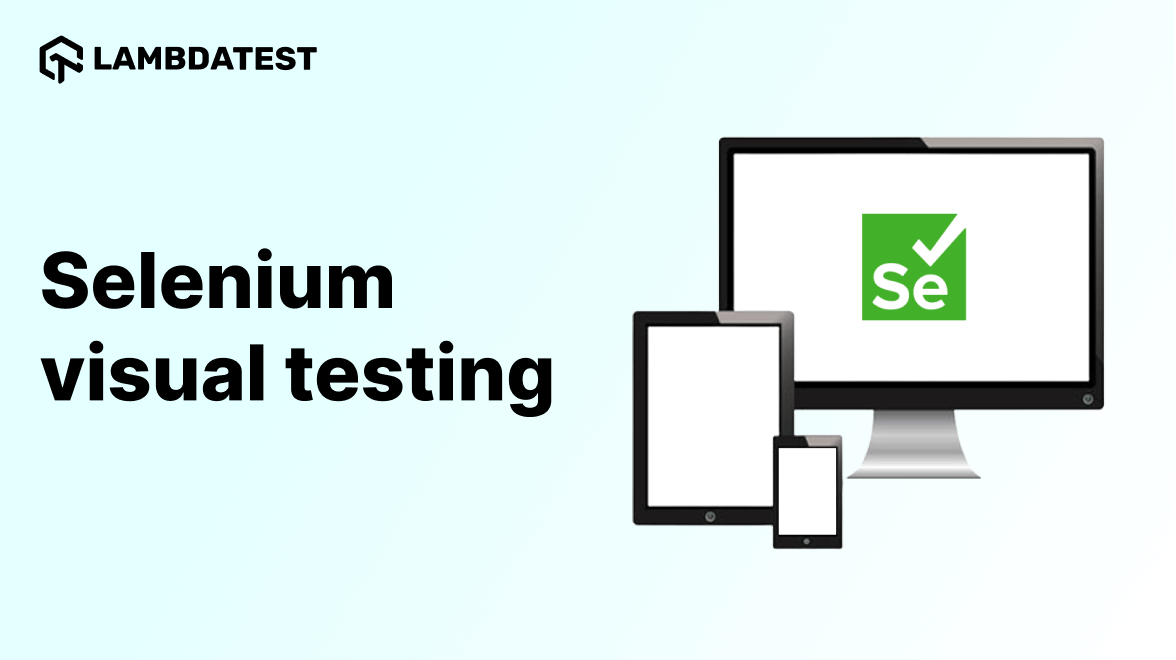Visual testing involves testing the user interface of an application to ensure that it looks and functions as expected. This type of testing is also sometimes referred to as GUI (Graphical User Interface) testing. Selenium is an open-source software testing framework used to automate browser tests in multiple operating systems. It is often used to automate visual testing, and it can be used to create a test suite to validate the look and feel of the application across different browsers and environments. In this article, we will discuss how to use the Selenium automation framework for visual testing.
What is Visual Testing?
Visual testing is a quality assurance practice which assesses the physical aspects of products by comparing what is seen during product inspection against the established standards. This may include the product’s shape and dimensions, images, colors, text, graphics, materials, and icons. Visual testing helps identify the presence of any defects, issues or flaws that may not be detected during functional or performance tests. It is a cost-effective and fast method for defect detection and can be used for a wide range of products such as electronic parts, medical equipment and automobiles.
Benefits of Visual Testing
Visual testing offers a number of key benefits.
- It is a fast, cost-effective and comprehensive method of product evaluation.
- By detecting defects quickly and accurately, it prevents issues from becoming more costly later on.
- Visual testing is also relatively simple and straightforward, and can be done easily by almost anyone, regardless of technical knowledge.
- It can also be used at any stage of product development, allowing users to identify any deficiencies earlier on in the process, allowing for more efficient and timely fixes.
Process Involved in Visual Testing
The process of visual testing consists of four key steps.
- The first step involves the identification of the product’s specifications, including physical characteristics, dimensions, and features.
- The second step involves the design of a set of test cases, or tests that are designed to determine that all product specifications are met and that any defects, issues or flaws are detected.
- The third step is to perform the actual tests.
- The fourth step is to document any defects that are found and to provide recommendations for corrective action.
Best Practices for Visual Testing
To ensure that visual testing is carried out accurately, efficiently, and effectively, it is important to follow certain best practices. Firstly, the test environment should be carefully designed and calibrated, as this will ensure accurate results. Secondly, detailed and thorough documentation should be done at every stage, to ensure that all results can be referenced back to and any discrepancies can be identified and addressed. Additionally, the testing process should be continually monitored and reviewed for any necessary improvements in order to ensure that the most accurate results are obtained.
Understanding Selenium
Selenium is a testing framework used for automated testing of web applications. It is an open source software and is widely used by developers and testers alike. Selenium is a suite of different tools, which when combined, provide a complete solution for web application testing. It allows testers to write, execute, and analyze tests. Selenium also has a great community of developers and users who are always providing useful feedback on how to use Selenium.
The main components of Selenium are the Selenium WebDriver, Selenium IDE, and Selenium Grid. The Selenium WebDriver is a tool used for automating web applications. It can be used to create automated tests for web applications, including visual tests. The Selenium IDE is a tool used for recording, editing, and debugging automated tests. The Selenium Grid is a distributed network of machines used to run automated tests in parallel.
What makes Selenium the First Choice for Testing?
Selenium is a powerful tool that is used by software developers and testers alike to automate and quickly perform tests. In this article, we will look at why Selenium is such a great tool for testing.
Selenium is an open source tool that is widely used in many organizations. It is a suite of software testing tools widely used for web applications and websites. It is a suite of software testing tools widely used for web applications and websites. Selenium is widely used for automation testing of web browsers as it provides a simple and easy-to-use interface to create, manage and execute tests.
One of the main reasons why Selenium is such a great tool for testing is that it is platform and language independent. Selenium can be used on any operating system and can be used with any language. This makes Selenium ideal for larger projects where multiple developers and testers are involved and where there are different development languages being used. This also makes Selenium great for teams that are distributed across different locations since developers and testers can use whatever language they are familiar with, regardless of location.
Another great feature of Selenium is that it is easy to install and use. The software can be downloaded for free and there are plenty of tutorials, guides and support available online. This makes it easier for users to quickly get up and running with the software.
Selenium also offers powerful scripting capabilities which allow testers to quickly script tests for applications. This enables testers to easily create tests for applications quickly and with minimal effort. Selenium also provides support for a wide range of web browsers, meaning tests can be executed on any browser quickly and efficiently.
Setting Up Selenium
In order to use Selenium for visual testing, a few steps must be taken in order to set up the environment. The first step is to download Selenium and install it on the machine being used for testing. The Selenium IDE must also be installed in order to create and debug scripts. Once the software is installed and configured, the test environment must be set up. This involves creating the test suite, setting up the test environment, and configuring the test data.
Once the environment is set up, the next step is to install the appropriate web browser driver. The web browser driver will allow Selenium to control the browser, and it must be of the same version as the web browser that is being tested. After the web browser driver is installed, the Selenium scripts can be written to begin the visual testing process.
Writing Scripts for Visual Testing
Writing scripts for visual testing can be done with the Selenium IDE. In the Selenium IDE, there are several commands used for visual testing. These include commands for taking screenshots, setting mouse coordinates, and extracting text from the application. When writing automated scripts for visual testing, it is important to consider the operating system, browser version, and other environment variables in order to test correctly.
In addition to the Selenium IDE, there are other tools that can be used to write scripts for visual testing such as Visual Studio Code, Atom, and WebDriverIO. These tools provide more flexibility and advanced features than the Selenium IDE, enabling complex test scripts to be created.
Best Practices for Visual Testing with Selenium
When using Selenium for visual testing, there are some best practices that should be followed in order to ensure that the tests are effective and efficient. First, tests should be written in a way that is repeatable and easily debugged. This can involve using variables and functions to make the scripts more maintainable.
Second, tests should be written with a goal in mind. This means that tests should be designed to cover the most important parts of the application that are essential for visual correctness. Third, changes to the application should be immediately followed by a test run to ensure that the changes have not affected the visual correctness of the application.
Finally, the tests should be written with good coding best practices. This includes writing well-organized, readable, and maintainable code. This helps make debugging and modifying the code easier.
Wrapping Up!
Selenium is a powerful tool that can be used for visual testing of web applications. By following the steps outlined in this article, it is possible to set up an environment and write scripts for visual testing. Additionally, best practices should be followed in order to ensure that the tests are effective and efficient. Visual testing can significantly improve the quality and performance of an application and is an essential part of the overall testing process.
You may start your Selenium visual testing using LambdaTest, a dependable, scalable, secure, and high-performing test execution cloud that enables development and testing teams to hasten their release cycles. Begin testing in parallel and significantly reduce your test execution time while being able to run your test scripts on 3000+ desktop and mobile devices. Testing with LambdaTest is free to begin with, register here.



GIPHY App Key not set. Please check settings